
History Arch. (819k)
From the Brazzaville entry in Wikipedia:
Brazzaville is the capital and largest city of the Republic of the Congo (RC). Constituting the financial and administrative center of the country, it is located on the north side of the Congo River, opposite Kinshasa, Democratic Republic of the Congo (DRC). The population of the capital is estimated to exceed 1.8 million residents, comprising more than a third of the national populace, 40% of whom are employed in non-agricultural professions. During World War II, Brazzaville was also the capital of Free France between 1940 and 1942. The RC became an independent country in 1960.
Brazzaville was founded by the French colonial empire upon an existing indigenous Bateke settlement called Ncuna, as part of the Scramble for Africa. The Italian-born explorer Pierre Savorgnan de Brazza, granted French citizenship in 1874, officially founded the settlement which commemorates his name on 10 September 1880. The local King, Makoko of the Téké, signed a treaty of protection with de Brazza which subjugated his lands to the French Empire. From October 1880 until May 1882 a small squad of troops led by Senegalese Sergeant Malamine Camara occupied the site, preventing the land from falling into Belgian hands. The first large scale building work of the city only began four years later in order as a competitor with Léopoldville (now Kinshasa) which Belgian colonists built on the other side of the river.
The Berlin Conference of 1884 placed French control over the area on an official footing. The city became the capital of the French Congo in 1904. It then continued as capital with the creation of French Equatorial Africa, a federation founded in 1910, of French colonial states which encompassed Gabon, the Central African Republic and Chad until 1960. 1910–1915 saw the construction of major municipal buildings, including a courthouse and headquarters for the Banque de l'AEF and Institut Pasteur. In 1934 the Congo-Océan railway came into service, linking Brazzaville with the Atlantic port of Pointe-Noire. Construction of the railway resulted in the death of over 17,000 Africans, which led to a revolt in 1928.
During World War II Brazzaville and the rest of French Equatorial Africa remained beyond the control of Vichy France; the city served as the capital of France Libre from 1940–1943. In 1944, Brazzaville hosted a meeting of the French resistance forces and representatives of France's African colonies. The resulting Brazzaville Declaration represented an attempt to redefine the relationship between France and its African colonies.
Until the 1960s, the city was divided into European (the center of the city) and African sections (Poto-Poto, Bacongo, and Makélékélé). In 1980 it became a "commune" separated from the surrounding Pool Department and divided into nine "arrondissements" (boroughs).
The city has frequently been a staging ground for wars, including conflicts between rebel and government forces and between forces of the RC, the DRC, and Angola. It was also the scene of bloody civil wars throughout the 1990s which resulted in thousands of civilian deaths and which forced hundreds of thousands of refugees to flee the city. More recently thousands of people leaving the DRC have found their way to Brazzaville; the local United Nations force and the DRC government have accused the city of deporting thousands of these refugees.
All pictures are © Dr. Günther Eichhorn, unless otherwise noted.
The History Arch in Brazzaville was built in 1966. It is clad in tiles with pictures from the history of the two Congo countries (the RC and the DRC), starting with scenes of local people before colonization through the time of slavery, to the modern era.






This basilica was planned from 1936. It was designed by French architect Roger Erell, merging European and local building techniques. Construction started in 1943 with support of Free France, the resistance movement in France during World War II. The basilica was consecrated in 1949. The building is striking with the bright green roof and the doors with copper panels depicting biblical scenes. The roof was originally completely covered with malachite. After significant storm damage, it was covered with other green material.
The description of the basilica is available in French.




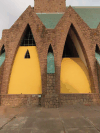
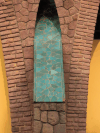


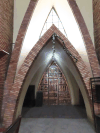
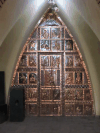
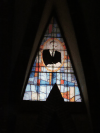
From the Sacred Heart Cathedral, Brazzaville entry in Wikipedia:
The Sacred Heart Cathedral or simply Cathedral of Brazzaville, is a religious building belonging to the Catholic Church and is located in the city of Brazzaville in the African country of the Republic of Congo.
The church is the seat of the Bishop of the Archdiocese of Brazzaville and is the oldest existing cathedral in central Africa. The building was built in 1892 and consecrated in 1894. The space was renovated in 1952 and 1993. The main entrance faces east and is decorated with two large polychrome statues of St. Paul and St. Peter, dating from before 1914. Charles de Gaulle visited it in 1944 and Pope John Paul II visited in 1980.
A more extensive description of the cathedral is available in French.



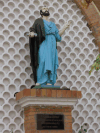
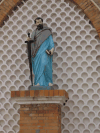


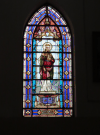
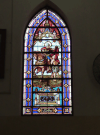
A short avenue, opposite the railway station of Brazzaville has busts of a number of notable people of the Republic of the Congo.

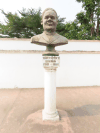
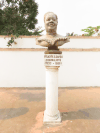

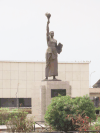


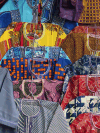






This page contains 40 pictures

Main page for Republic of the Congo
Page last updated on Tue Sep 24 18:19:03 2019 (Mountain Standard Time)
Page last updated on Tue Apr 23 21:31:06 2024 (Mountain Standard Time)
Brazzaville, Republic of the Congo on gei.geichhorn.com